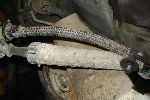Buffalosports
Well-Known Member
- Joined
- March 9, 2008
- Messages
- 504
- Reaction score
- 0
- City, State
- Buffalo, New York
- Year, Model & Trim Level
- 1998 Sport - 4WD
As you can see in my previous couple posts, I have been having trouble with my brakes. I appologize if I am getting annoying with these posts. My brakes where barely working and the peddle was soft. I went through and lubricated all the sliders on my calipers with no better result. Next, I went through and bleed all the calipers by pumping up the brakes and opening the bleeder. No air came out, fluid would squirt everywhere with no spitting or signs of air. Again, same result, very soft peddle. Next, I went on to replace the master cylinder. The master cylinder was bench bleed and all breaking lines are now reattached. Obvisouly, I need to bleed the system again but this time, I would think it should be much more difficult. I think I am going to go and pick up a Mightyvac (or something similar ex.: Harbor freight cheapo).
my First question is, how do I do it with the pump? What Psi am I looking for?
Second, does the ABS pump need to be blead? How would I go about doing this. My explorer is a 98 sport with 4 wheel disc brakes.
Third, I know the order in which I should bleed the calipers. Should the master cylinder be bleed first or last?
my First question is, how do I do it with the pump? What Psi am I looking for?
Second, does the ABS pump need to be blead? How would I go about doing this. My explorer is a 98 sport with 4 wheel disc brakes.
Third, I know the order in which I should bleed the calipers. Should the master cylinder be bleed first or last?










